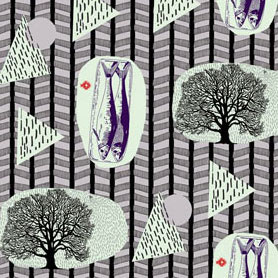Wendy Marchbanks
Textile Designer and Illustrator
Primary design concentration:
Printed Textile Design
Most preferred tool for designing:
Fine-liner pen, Layout paper, Computer
1. How and why did you choose to become a designer?
When I was looking at courses after my A-level, it was a choice between the Art’s Foundation and a degree in Audiology (an ear specialist)—pretty different ends of the spectrum. I knew it wasn’t going to be an easy route to make a living out of art, and thought the Audiology would be a safer bet. It probably would have been in many ways, I’d probably have a proper well-paid 9–5 job, but it really wasn’t what I was passionate about. My brain thinks in a very creative way, and art came easily to me—I think you have to follow what comes naturally to you. I never knew where in the world of art I’d end up, Textile Design just sort of came to me.
2. Challenges you encounter as a designer and how do you deal with them?
It’s tricky always finding new inspiration and keeping your ideas and style fresh. I try as much as I can not to look at other current designers when I’m researching, because it’s too easy to loose your own style, and then you end up subconsciously producing something similar to what’s already out there.
3. Your definition of an “elegant solution,” that is, good design?
Simple, conclusive, and most of all, imaginative.
4. From skills to values, what makes a designer successful?
You have to keep moving and evolving, but at the same time know what your core values are. It’s quite easy to get lost in the world of design, you have to have a clear sense of who you are, and where you work fits in, and that only becomes clearer the longer you work at it. If you look at the really successful designers and illustrators, they are more like a brand—you can recognise their work from a mile off and people come to them with a clear idea of what service they will get.
5. How do you stay motivated and grow personally and professionally as a designer?
It’s essential as a freelance designer that you are self-motivated, and I’m lucky that this is a quality I do have. When you’re freelancing, everything comes from within you, you have to drive things forward, you’re the only one that can make things happen. It can be hard at times if work is quiet, but I’ve found the key is to just keep going. When you stop designing for a couple of weeks, months, it gets harder and harder to get back into it, so I am constantly working on my own personal projects, or thinking about my next venture.
6. For those aspiring to become a designer, whatever the discipline, what is your advice?
There’s no getting around the fact that it is tough and increasingly becoming more and more competitive, but if it’s what you want to do and you’re determined, then it definitely has a lot to offer as an alternative to a typical 9–5 job in an office. I think you need to constantly be thinking what you, as a designer, can bring to the table that’s new. You may not know this until the final year of your degree or even MA, but you should always be aiming throughout your work to approach things from a new perspective.
7. What is your quest in design?
To add a little imagination into people’s lives.
Previous: Elizabeth Joy Gershenzon and Travis Kochel | Next: Rebecca Wilson

Support this solo initiative
What began as a collection of links has evolved into a comprehensive archive committed to creative culture—offering so far 395 interviews with under-the-radar Artists, Designers & Makers, in addition to 202 write-ups across events, books, movies, more. Free to explore. Free from ads. If you gain a level of motivation, knowledge, even delight, from Design Feast, please support on Patreon. Thanks for your consideration!
Wishing you continual success,
Nate Burgos, Content Creator & Publisher
Comments
There are no comments yet.
Leave Your Comment